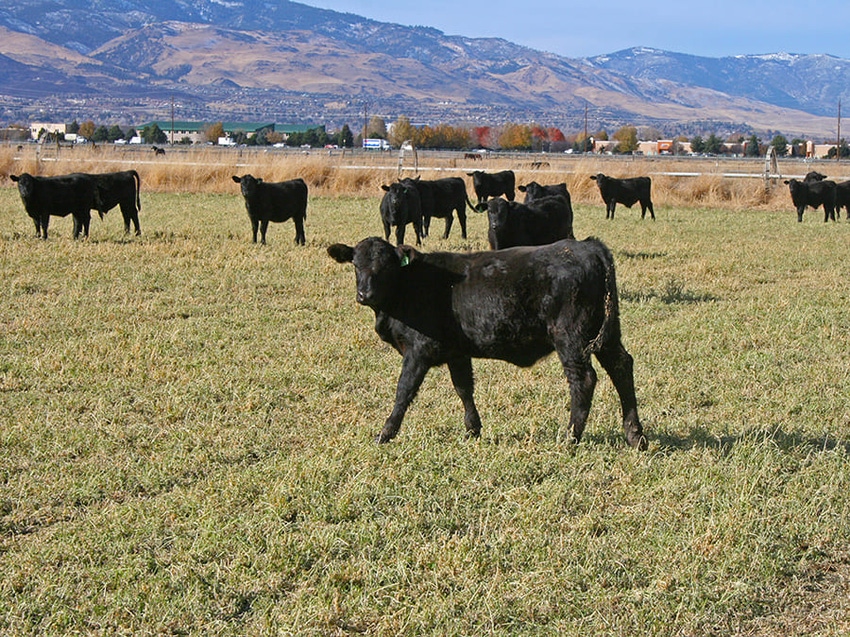Beware! Bloat happens
If you are grazing legumes in your pasture, be on the look out for bloat.
April 21, 2021

Bloat has been described in agricultural writings since A.D. 60. Names for bloat have changed over the years: hoove, hoven, tympany, and blown have appeared in English journals of the 18th and 19th centuries.
Bloat occurs when rumen gas production exceeds the rate of gas elimination. The gas accumulates and causes distention of the rumen (left side of cattle). If the situation continues, the inflated rumen interferes with respiration. The problem is worsened by the absorption of carbon dioxide (CO2) from the rumen. Death is normally due to suffocation.
Bloat is often associated with discontinuous grazing, such as the removal of animals from legumes pastures overnight. Pasture bloat may occur when grazing is interrupted by adverse weather, such as storms, or biting flies. Anything that alters normal grazing habits will increase the incidence of bloat. The following are a list of forages and their bloat potential:
Forage species and their potential for causing bloat in cattle:
High Potential | Low Potential | Considered Safe |
Alfalfa | Arrowleaf clover | Birdsfoot trefoil |
Sweetclover | Spring wheat | Cicer milkvetch |
Red clover | Oats | Crownvetch |
White clover | Rape | Lespedeza |
Alsike clover | Perennial ryegrass | Fall rye |
Winter wheat |
| Most grasses |
Alfalfa can cause bloat in the spring, summer, and fall. Fall bloat conditions are caused by frequent heavy dew or fall frost. After a killing frost (not to be confused with first frost), alfalfa has a reputation of being bloat-safe. However, as long as the plant remains green, there is potential for bloat. Nitrogen fertilizer and frequent, heavy grazing will reduce the amount of alfalfa in a stand.
Bloat is often classified as being either pasture or feedlot bloat. It is more accurate to identify it as being either free-gas bloat or frothy bloat. Frothy bloat normally occurs in cattle eating legumes or lush grasses as well as in feedlot cattle. Free-gas bloat is less common on pasture or in the feedlot.
In situations of frothy bloat, gas production may not be greatly increased but the gases, mainly CO2 and methane (CH4), are trapped in foam or froth. The foam or froth interferes with the expulsion of gases resulting from normal fermentation in the rumen.
Preventing Bloat on Pasture
Manage pasture for no more than 50% legumes. (This has little value if selective grazing is possible)
Fill cattle on dry roughage or grass pasture before turning out on a legume pasture.
Do not initially turn cattle on pasture wet with dew or rain.
Once cattle are turned to pasture, don’t remove at the first signs of bloat. Watch them closely and remove only those whose condition continues to worsen if it is a small percentage of the total number.
If green chop is being fed, spread the intake over several feedings while the cattle are getting adapted.
Livestock Diet Supplements:
* Feed anti-foaming chemicals like poloxalene can prevent pasture bloat for about 12 hours if consumed in adequate amounts. Begin feeding two to five days before turning onto pasture. Poloxalene can be fed as a topdressing, in a grain mix, in liquid supplements, or in molasses blocks. The blocks work best when scattered around the entire field at a density of about one block for every 10 head of cattle. The blocks are not as effective if they are placed only near the water supply. The blocks are more effective in small fields than in large ones. Because poloxalene is relatively expensive, some producers reduce the dosage or eliminate its use after livestock have been grazing pasture for several weeks.
* Provide supplements or molasses blocks containing bloat-reducing compounds such as an ionophore (example: Rumensin®).
A few recommendations from the past seem unusual today, for example, “feather burnt, and held for some time while in full smoke, close under the nose of the animal”(1795); and “a pint of gin to each animal”(1925). Some of the early suggestion still have merit. For example, placing an animal’s front feet on a mound so that the front feet are higher than the back feet helped to ease bloat because the esophagus was thus elevated and the gas was expelled more easily. Walking was a commonly used treatment for bloat and was effective if used before bloat reached the acute stage. Another method involves placing a stick or rope through an animal’s mouth to encourage salivation, which breaks down rumen foam.
Treatment: Free-gas bloat can usually be relieved by inserting a 3/4” rubber hose into the rumen via the esophagus. If “hosing” does not give immediate relief, a defoaming agent (poloxalene) should be administered through the hose to break the surface tension of the ingesta. A pint of mineral oil is also a defoamer. Drenching should be avoided because of the danger of inhalation by the bloated animal which can cause immediate death or lead to pneumonia. Similarly, a hose placed in the rumen will have a gurgling sound and the smell of ammonia, whereas a hose that has passed into the lungs will have the sounds of breathing. Use of a speculum (a steel tube) placed in the mouth will help in passing the hose and prevent the animal from chewing the hose. A trocar should be used as a last resort and veterinarian should be contacted if this is or going to be done. Chronic bloaters should be shipped for slaughter.
Source: Ohio State University, which is solely responsible for the information provided and is wholly owned by the source. Informa Business Media and all its subsidiaries are not responsible for any of the content contained in this information asset.
You May Also Like



